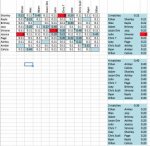I used to be good in math but school was long time ago lol
So, I'm watching this dating show and trying to calculate probabilities.
There are 10 guys and 10 girls. Each guy is a perfect match with only one girl. We don't know those matches yet.
All 10 couple up and we get the first clue: 4 couples are a match, the other 6 are not. We don't know who the 4 correct matches are. So probability for each couple is 0.4
All 10 couple up and we get the second clue: 2 couples are a match, the other 8 are not. Probability of 0.2
Now, 3 couples were the same in the first and the second clue. Those have a higher probability to be a match, right? But 0.4 + 0.2 = 0.6 seems not to be right...
I got stuck!
Help!
So, I'm watching this dating show and trying to calculate probabilities.
There are 10 guys and 10 girls. Each guy is a perfect match with only one girl. We don't know those matches yet.
All 10 couple up and we get the first clue: 4 couples are a match, the other 6 are not. We don't know who the 4 correct matches are. So probability for each couple is 0.4
All 10 couple up and we get the second clue: 2 couples are a match, the other 8 are not. Probability of 0.2
Now, 3 couples were the same in the first and the second clue. Those have a higher probability to be a match, right? But 0.4 + 0.2 = 0.6 seems not to be right...
I got stuck!
Help!

